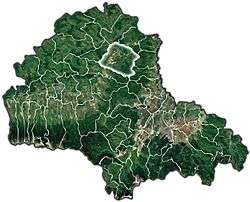Hoghiz
| Hoghiz Olthévíz | |
|---|---|
| Commune | |
 | |
 | |
 Hoghiz | |
| Coordinates: 45°59′N 25°18′E / 45.983°N 25.300°E | |
| Country |
|
| County | Brașov County |
| Area | 174.16 km2 (67.24 sq mi) |
| Population (2011)[1] | 4,852 |
| Time zone | EET (UTC+2) |
| • Summer (DST) | EEST (UTC+3) |
Hoghiz (German: Warmwasser; Hungarian: Hévíz or Olthévíz) is a commune in Brașov County, Romania. It is composed of six villages: Bogata Olteană (Oltbogát), Cuciulata (Katscheloden; Kucsuláta), Dopca (Dopich; Datk), Fântâna (Olthidegkút), Hoghiz and Lupșa (Lupsa).
At the 2011 census, 68.4% of inhabitants were Romanians, 27.8% Hungarians and 3.6% Roma. At the 2002 census, 66.4% were Romanian Orthodox, 17.6% Unitarian, 8.4% Reformed, 3.1% Pentecostal and 2.8% Roman Catholic.
Villages
Cuciulata
Cuciulata village was first attested in a document of 1372 as Vila Roczolod. It also appears as Kucsalota (1589), Kucstulata (1637) and Kociulata (1648). It is located on the south banks of Olt River at the base of the Perșani Mountains, and is crossed by Lupşa Creek. The road DJ104 passes through the village center and DC20 road connects Cuciulata to Lupșa village. Archaeological excavations have shown the existence of a settlement in this place in the Bronze Age. The ruins of a 1st-century BC Dacian stronghold have also been discovered. Among the monuments in the village are a wooden church dating from 1700-1752 and a stone Orthodox church from 1784-1791.
Natives
See also
Coordinates: 45°59′N 25°18′E / 45.983°N 25.300°E
References
- ↑ Romanian census data, 2011 Archived 2013-07-23 at the Wayback Machine.; retrieved on March 17, 2012
